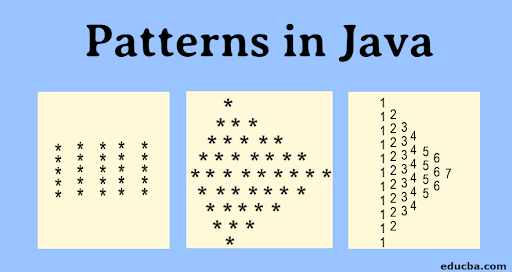
This establishes a central store for the theme value (initially set to ‘light’). The App component wraps its children (Toolbar and Content) with a ThemeContext.Provider, making the current theme value available to them and any nested components. Both Toolbar and Content can then access the theme using useContext(ThemeContext). First, we create a BankAccount, which is an abstract class that will contain information commonly used for specific Accounts. Design patterns differ by their complexity, level ofdetail and scale of applicability. In addition,they can be categorized by their intentand divided into three groups.
Behavioral Design Patterns
We can apply a singleton pattern on the factory class or make the factory method static. Java design patterns are divided into three categories - creational, structural, and behavioral design patterns. We can apply solutions to commonly occurring problems by knowing design patterns in software design. The Factory pattern provides an interface for creating objects in a super class, allowing subclasses to decide which class to instantiate.
Using React Context Hook
It promotes loose coupling by eliminating the need for clients to know about the concrete classes. They help to abstract the instantiation process and make the code more flexible, reusable, and maintainable. Two classes, Rectangle and Circle, implement the Shape interface and override the clone() method. The clone() method creates a new instance of the class and copies the properties of the original object. When using the prototype pattern, you can create a new object by simply calling the clone() method on an existing object, avoiding the need for complex object initialization logic. Design patterns emerged from the field of architecture, where architects faced similar problems in building structures that required the use of common solutions.
Step 5
In this example, the client initializes a new instance by cloning the original prototype, showcasing the simplicity and efficiency of the Prototype pattern. As you experiment with this code, consider scenarios where modifications to the cloned object are necessary post-cloning. While the Prototype pattern provides a baseline for creating copies, customization might be required to adapt the cloned object to specific requirements.
Concrete Element
In cases where the object contains complex data structures or references, a shallow copy might not be sufficient. Deep cloning involves creating copies of the entire object structure, ensuring a more profound level of independence between the original and the clone. The Strategy pattern defines a family of algorithms, encapsulates each one, and makes them interchangeable. It's useful when you have multiple ways to solve a problem and want to choose an algorithm at runtime. The Prototype pattern involves creating new objects by cloning existing ones. It is useful when object creation is expensive or complex, and you want to avoid duplicating the effort.
Creational design patterns
Moreover, if the changes are factory specific, then you may need to change other classes as well. The dynamic nature of the Prototype pattern empowers developers to adapt to changing requirements without the need for extensive modifications to the codebase. The Memento pattern captures and externalizes an object's internal state so that the object can be restored to this state later. The Command pattern encapsulates a request as an object, allowing you to parameterize clients with different requests, queue or log requests, and support undoable operations. The Flyweight pattern uses sharing to support large numbers of fine-grained objects efficiently.

Render Props offer a unique way to achieve customization in React components. They allow you to pass down rendering logic as a prop to a component, giving the consuming component control over how its data is displayed. This pattern is particularly useful when you have a generic component that needs to be adaptable to different data formats or presentation styles.
However, this will lead to the create(AccountType type) method becoming increasingly bloated. The first strength of the Factory pattern that we can see is that it centralizes the creation of objects in one place. Using design patterns speeds up your design and helps to communicate your design to other team members.

Clients interact with the Facade class, which simplifies the interaction with the subsystems. The Circle class (refined abstraction) extends Shape and overrides the draw() method, delegating the call to the Renderer member. The VectorRenderer and RasterRenderer classes (concrete implementors) implement the Renderer interface and override the renderCircle() method.
You should favor composition over inheritance in Java. Here's why. - Oracle
You should favor composition over inheritance in Java. Here's why..
Posted: Thu, 14 Jul 2022 07:00:00 GMT [source]
Whether you’re a beginner just starting out with Java, or an experienced developer looking to deepen your understanding of design patterns, we hope this guide has been a valuable resource. The Singleton pattern has several advantages, such as controlled access to the sole instance, reduced namespace, and the ability to permit a variable number of instances. However, it can be difficult to unit test due to its global access nature, and it may mask bad design, such as not defining proper objects for the job. The Singleton pattern is a design pattern that restricts the instantiation of a class to a single instance. This is useful when exactly one object is needed to coordinate actions across the system. The dependency injection pattern allows us to remove the hard-coded dependencies and make our application loosely-coupled, extendable, and maintainable.
It can also be seen as a template for how to solve a problem that can occur in many different situations and/or applications. It is not code reuse as it usually does not specify code, but code can be easily created from a design pattern. Object-oriented design patterns typically show relationships and interactions between classes or objects, without specifying the final application classes or objects that are involved.
The sticking point is that singletons remain in memory for the life of an application, making them a potential drain on system resources. On the other hand, having one object in memory is preferable to having many instances existing simultaneously. The Factory Design pattern is used when we have a superclass with multiple subclasses and, based on input, we need to return one of the subclasses. Developers can apply a Singleton Pattern on the factory class or make the factory method static.
Instead of explaining a common concept to someone else, you can simply tell them to utilize a certain pattern.
If you are not well aware of these concepts then I will suggest to go through our short tutorial on Java Programming. The interpreter pattern is used to define a grammatical representation of a language and provides an interpreter to deal with this grammar. State Method is a Behavioral Design Pattern, it allows an object to alter its behavior when its internal state changes. The pattern restricts direct communications between the objects and forces them to collaborate only via a mediator object. Turns a request into a stand-alone object that contains all information about the request.

No comments:
Post a Comment